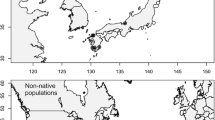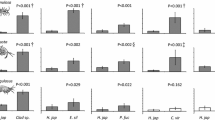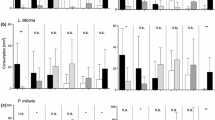Abstract
Phenotypic plasticity could be a key mechanism of successful species invasion. Few studies, however, have evaluated whether a non-indigenous species induces anti-herbivore defenses after its introduction to new habitats. We tested how a non-indigenous (Mastocarpus stellatus) and a native red seaweed (Chondrus crispus) responded to grazing by a periwinkle (Littorina littorea) and an isopod (Idotea granulosa) in Helgoland, Germany. In the donor region of the Mastocarpus population, that is Iceland, the periwinkle is missing, whereas the isopod is present. Our results indicate that Mastocarpus experienced less consumption by Littorina (but not by Idotea) than Chondrus. Moreover, Mastocarpus induced defenses in response to Idotea (but not to Littorina) grazing, whereas Chondrus induced anti-herbivory responses to both species of herbivores. Grazed Mastocarpus grew equally to non-grazed conspecifics, while growth of grazed Chondrus was lower than of ungrazed conspecifics. Hence, the non-indigenous Mastocarpus responded differently to grazing stress than the native Chondrus with respect to anti-herbivory and compensatory responses, which perhaps supported the successful Mastocarpus establishment in a new range.




Similar content being viewed by others
References
Agrawal AA (2005) Future directions in the study of induced plant responses to herbivory. Entomol Exp Appl 115:97–105
Allan E, Crawley MJ (2011) Contrasting effects of insect and molluscan herbivores on plant diversity in a long-term field experiment. Ecol Lett 14:1246–1253. doi:10.1111/j.1461-0248.2011.01694.x
Bartsch I, Kuhlenkamp R (2000) The marine macroalgae of Helgoland (North Sea): an annotated list of records between 1845 and 1999. Helgol Mar Res 54:160–189
Buschbaum C, Chapman AS, Saier B (2006) How an introduced seaweed can affect epibiota diversity in different coastal systems. Mar Biol 148:743–754
Cańo L, Escarré J, Vrieling K, Sans FX (2009) Palatability to a generalist herbivore, defence and growth of invasive and native Senecio species: testing the evolution of increased competitive ability hypothesis. Oecologia 159:95–106
Cronin G, Hay ME (1996) Susceptibility to herbivores depends on recent history of both the plant and animal. Ecology 77:1531–1543
Cyr H, Pace ML (1993) Magnitude and patterns of herbivory in aquatic and terrestrial ecosystems. Nature 361:148–150
Dworjanyn SA, de Nys R, Steinberg PD (2006) Chemically mediated antifouling in the red alga Delisea pulchra. Mar Ecol Prog Ser 318:153–163
Eigenbrode SD, Andreas JE, Cripps MG, Ding H, Biggam RC, Schwarzlander M (2008) Induced chemical defenses in invasive plants: a case study with Cynoglossum officinale L. Biol Invasions 10:1373–1379
Elton CS (1958) The ecology of invasions by animals and plants. University of Chicago Press, Chicago
Eschweiler N, Molis M, Buschbaum C (2009) Habitat-specific size structure variations in periwinkle populations (Littorina littorea) caused by biotic factors. Helgol Mar Res 63:119–127
Fordyce JA (2006) The evolutionary consequences of ecological interactions mediated through phenotypic plasticity. J Exp Biol 209:2377–2383
Hahn A (2008) Effekte einer invasiven Spezies und nativer Weidegänger auf die Besiedlung und das Überleben habitatbildender Makroalgen an der Helgoländer Küste. Diploma thesis, University of Leipzig, Leipzig
Hay ME, Kappel QE, Fenical W (1994) Synergisms in plant defenses against herbivores: interactions of chemistry, calcification, and plant quality. Ecology 75:1714–1726
Ingolfsson A (2006) The intertidal seashore of Iceland and its animal communities. University of Copenhagen, Copenhagen
Jormalainen V, Honkanen T (2008) Macroalgal chemical defenses and their roles in structuring temperate marine communities. In: Amsler CD (ed) Algal chemical ecology. Springer, Berlin, pp 57–89
Jormalainen V, Ramsay T (2009) Resistance of the brown alga Fucus vesiculosus to herbivory. Oikos 118:713–722. doi:10.1111/j.1600-0706.2008.17178.x
Joshi J, Vrieling K (2005) The enemy release and EICA hypothesis revisited: incorporating the fundamental difference between specialist and generalist herbivores. Ecol Lett 8:704–714
Karban R, Baldwin IT (1997) Induced responses to herbivory. University of Chicago Press, Chicago
Karban R, Nagasaka K (2004) Are defenses of wild radish populations well matched with variability and predictability of herbivory? Evol Ecol 18:283–301
Karban R, Agrawal AA, Thaler JS, Adler LS (1999) Induced plant responses and information content about risk of herbivory. Trends Ecol Evol 14:443–447
Keane RM, Crawley MJ (2002) Exotic plant invasions and the enemy release hypothesis. Trends Ecol Evol 17:164–170
Koricheva J (2002) Meta-analysis of sources of variation in fitness costs of plant antiherbivore defenses. Ecology 83:176–190
Kornmann P, Sahling PH (1994) Meeresalgen von Helgoland: zweite Ergänzung. Helgol Wiss Meeresunters 48:365–406
Lankau RA, Rogers WE, Siemann E (2004) Constraints on the utilisation of the invasive Chinese tallow tree Sapium sebiferum by generalist native herbivores in coastal prairies. Ecol Entomol 29:66–75
Long JD, Trussell GC (2007) Geographic variation in seaweed induced responses to herbivory. Mar Ecol Prog Ser 333:75–80
Lowell RB, Markham JH, Mann KH (1991) Herbivore-like damage induces increased strength and toughness in a seaweed. Proc R Soc Lond B Biol Sci 243:31–38
Lüning K (1990) Seaweeds: their environment, biogeography and ecophysiology. Wiley, New York
Lyons DA, Scheibling RE, Van Alstyne KL (2010) Spatial and temporal variation in DMSP content in the invasive seaweed Codium fragile ssp fragile: effects of temperature, light and grazing. Mar Ecol Prog Ser 417:51–61
Metlen KL, Aschehoug ET, Callaway RM (2009) Plant behavioural ecology: dynamic plasticity in secondary metabolites. Plant, Cell Environ 32:641–653
Mitchell CE, Agrawal AA, Bever JD, Gilbert GS, Hufbauer RA, Klironomos JN, Maron JL, Morris WF, Parker IM, Power AG, Seabloom EW, Torchin ME, Vázquez DP (2006) Biotic interactions and plant invasions. Ecol Lett 9:726–740
Molis M, Korner J, Ko YW, Kim JH, Wahl M (2006) Inducible responses in the brown seaweed Ecklonia cava: the role of grazer identity and season. J Ecol 94:243–249
Molis M, Körner J, Ko YW, Kim JH (2008) Specificity of inducible seaweed anti-herbivory defences depends on identity of macroalgae and herbivores. Mar Ecol Prog Ser 354:97–105
Monteiro CA, Engelen AH, Santos ROP (2009) Macro- and mesoherbivores prefer native seaweeds over the invasive brown seaweed Sargassum muticum: a potential regulating role on invasions. Mar Biol 156:2505–2515
Paul C, Pohnert G (2011) Production and role of volatile halogenated compounds from marine algae. Nat Prod Rep 28:186–195
Paul VJ, Williams RR (2008) Marine chemical ecology. Nat Prod Rep 25:662–695
Quinn GP, Keough MJ (2002) Experimental design and data analysis for biologists. University Press, Cambridge
Reichert K, Buchholz F (2006) Changes in the macrozoobenthos of the intertidal zone at Helgoland (German Bight, North Sea): a survey of 1984 repeated in 2002. Helgol Mar Res 60:213–223
Rice WR (1989) Analyzing tables of statistical tests. Evolution 43:223–225
Rohde S, Molis M, Wahl M (2004) Regulation of anti-herbivore defence by Fucus vesiculosus in response to various cues. J Ecol 92:1011–1018
Siemann E, Rogers WE (2003) Herbivory, disease, recruitment limitation, and success of alien and native tree species. Ecology 84:1489–1505
Smith LD (2009) The role of phenotypic plasticity in marine biological invasions. In: Rilov G, Crooks JA (eds) Biological invasions in marine ecosystems Ecological, management, and geographic perspectives. Springer, Berlin, pp 177–202
Sotka EE, Whalen KE (2008) Herbivore offense in the sea: the detoxification and transport of algal secondary metabolites. In: Amsler C (ed) Algal chemical ecology. Blackwell, London, pp 203–228
Toth G (2007) Screening for induced herbivore resistance in Swedish intertidal seaweeds. Mar Biol 151:1597–1604
Toth GB, Pavia H (2007) Induced herbivore resistance in seaweeds: a meta-analysis. J Ecol 95:425–434
Trowbridge CD (2004) Emerging associations on marine rocky shores: specialist herbivores on introduced macroalgae. J Anim Ecol 73:294–303
Van Alstyne KL (1989) Adventitious branching as a herbivore-induced defense in the intertidal brown alga Fucus distichus. Mar Ecol Prog Ser 56:169–176
Verhoeven KJF, Biere A, Harvey JA, van der Putten WH (2009) Plant invaders and their novel natural enemies: who is naive? Ecol Lett 12:107–117
Wikström SA, Steinarsdottir MB, Kautsky L, Pavia H (2006) Increased chemical resistance explains low herbivore colonization of introduced seaweed. Oecologia 148:593–601
Winer BJ, Brown DR, Michels KM (1991) Statistical principles in experimental design. McGraw-Hill, New York
Yun HY, Rohde S, Linnane K, Wahl M, Molis M (2010) Seaweed-mediated indirect interaction between two species of meso-herbivores. Mar Ecol Prog Ser 408:47–53
Acknowledgments
We thank Andreas Wagner, Annekathrin Enge, and Susanne Wollgast for assistance in setting up experiments and Nelson Valdivia for assistance in the field. We are grateful to Maria B. Steinarsdόttir for providing M. stellatus samples from Iceland.
Author information
Authors and Affiliations
Corresponding author
Additional information
Communicated by F. Bulleri.
Rights and permissions
About this article
Cite this article
Yun, H.Y., Molis, M. Comparing the ability of a non-indigenous and a native seaweed to induce anti-herbivory defenses. Mar Biol 159, 1475–1484 (2012). https://doi.org/10.1007/s00227-012-1926-5
Received:
Accepted:
Published:
Issue Date:
DOI: https://doi.org/10.1007/s00227-012-1926-5




